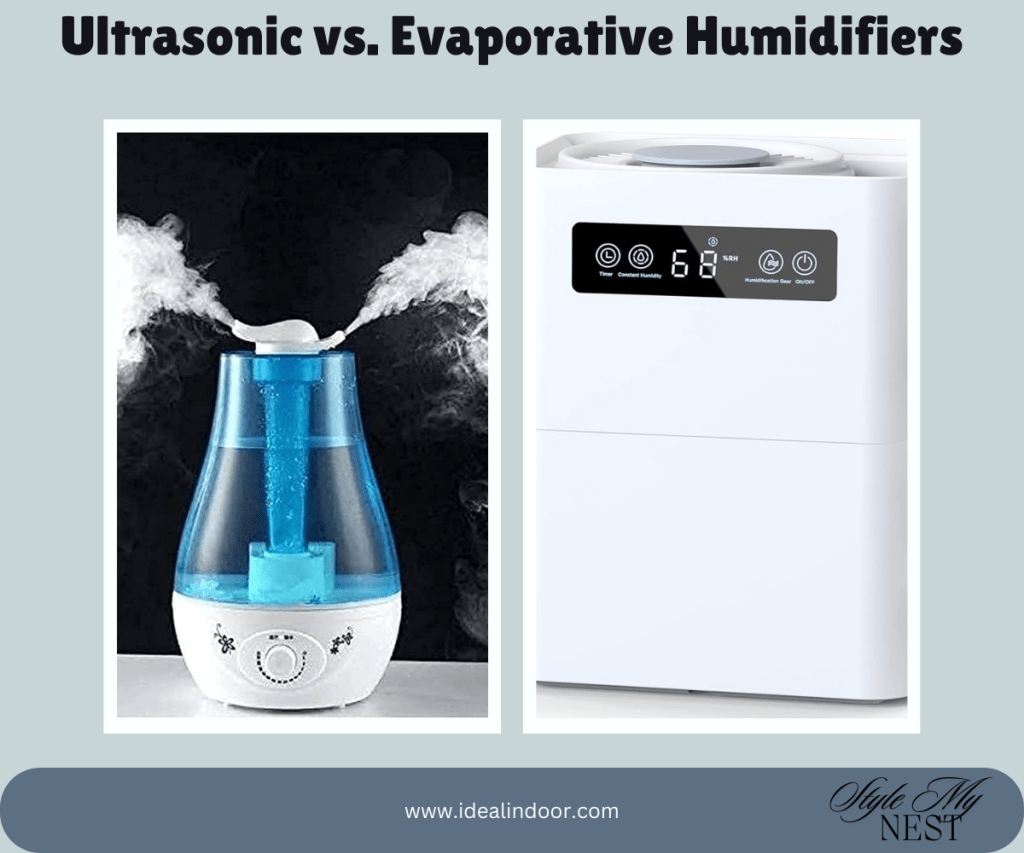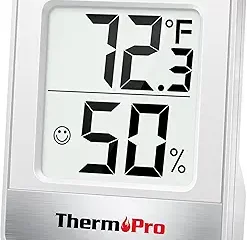Maintaining the right indoor humidity is crucial for comfort and health, especially during dry winters or in arid climates. If you’ve ever experienced dry skin, irritated sinuses, or static electricity in your home, chances are your air could use more moisture. Humidifiers are a great solution, but with so many types available, it can be tough to decide which is right for you.
In this article, we’ll break down the differences between ultrasonic and evaporative humidifiers, help you understand which one is better suited for your needs, and even share some real-life experiences to give you a clearer picture.

Table of Contents
ToggleWhy Indoor Humidity Matters?
Proper indoor humidity does more than just keep you comfortable—it can improve your health, protect your belongings, and even extend the life of your home’s infrastructure. Ideally, indoor humidity should be kept between 30% and 50%. Too low, and you risk respiratory issues and discomfort. Too high, and you open the door to mold and dust mites.
So, how do you choose the right humidifier to maintain this balance? Let’s dive into the two most popular types—ultrasonic and evaporative humidifiers.
What is an Ultrasonic Humidifier?
Ultrasonic humidifiers are a modern, high-tech option that use sound vibrations to turn water into a fine mist. These high-frequency vibrations break down water molecules, sending mist into the air, which increases the moisture levels in your room.
What makes ultrasonic humidifiers especially popular is their silent operation. You won’t hear any loud fans or buzzing, making them perfect for bedrooms or offices where you need quiet.
“Ultrasonic humidifiers are a great choice for those seeking a nearly silent, high-efficiency device. They work well in smaller rooms, but users should be mindful of cleaning the tank regularly to avoid bacteria build-up.”
— Dr. Jane Hall, Indoor Air Quality Specialist
They also tend to be energy-efficient, which is a bonus if you plan to run them for extended periods.

What is an Evaporative Humidifier?
Evaporative humidifiers use a more natural process to add moisture to the air. These devices draw air through a wick filter that absorbs water from the tank. A fan then blows air over this damp filter, allowing the moisture to evaporate into the room.
One of the best things about evaporative humidifiers is that they are self-regulating—they only release moisture as needed. This makes them less likely to over-humidify a space, which can sometimes happen with ultrasonic models.
“Evaporative humidifiers excel in larger spaces where consistent humidity is needed without the risk of over-saturating the air. Their natural evaporation process ensures you won’t end up with damp furniture or floors.”
— Susan Leary, Environmental Health Expert
Difference Between Ultrasonic and Evaporative Humidifiers
The primary difference between ultrasonic and evaporative humidifiers lies in how they generate moisture. Both work well, but there are key factors to consider based on your specific needs.
Technology and Operation
- Ultrasonic humidifiers use vibrations to create mist, while evaporative humidifiers rely on evaporation with a fan.
- If you prefer something quiet and high-tech, the ultrasonic model is your go-to. For those who like simplicity and natural moisture control, an evaporative humidifier is ideal.
Noise Levels
Noise is a major factor, especially if you’re a light sleeper or need a humidifier for your bedroom or office.
- Ultrasonic models are whisper-quiet. You won’t hear a thing, which makes them perfect for quiet environments.
- Evaporative humidifiers, on the other hand, have a fan that produces a gentle hum. While it’s not overly loud, it’s definitely noticeable in a quiet room.
Maintenance and Cleaning
Maintenance is where these two types differ significantly.
- Ultrasonic humidifiers require regular cleaning to prevent bacterial growth in the water tank, especially if you use tap water.
- Evaporative humidifiers need less frequent cleaning, but their wick filters should be replaced every few months.
Ultrasonic vs. Evaporative Humidifiers
| Feature | Ultrasonic Humidifier | Evaporative Humidifier |
|---|---|---|
| Technology | Uses high-frequency vibrations to create a fine mist | Uses a wick filter and fan to evaporate water |
| Noise Level | Extremely quiet (silent operation) | Produces moderate fan noise |
| Room Size Suitability | Best for small to medium-sized rooms (bedrooms, offices) | Best for larger spaces (living rooms, open areas) |
| Energy Efficiency | Highly energy-efficient, uses less electricity | Consumes more energy due to the fan |
| White Dust | Can produce white dust if tap water is used | No white dust |
| Maintenance | Requires regular cleaning to prevent mold and bacteria | Requires wick filter changes every few months |
| Cost | Generally more expensive upfront | Generally more affordable, but filter costs add up |
| Moisture Output | Produces a fine mist, can over-humidify small spaces | Natural evaporation, self-regulates moisture output |
| Best For | Quiet environments like bedrooms or nurseries | Large, open spaces and areas with higher humidity needs |
Which is Better: Ultrasonic vs. Evaporative Humidifiers?
Now, the big question: which one is better for your home? The answer depends on several factors, including your room size, noise tolerance, and how much maintenance you’re willing to do.
Best for Small vs. Large Spaces
- Ultrasonic humidifiers are perfect for smaller to medium-sized rooms like bedrooms, offices, or nurseries. Their quiet operation makes them ideal for spaces where noise is an issue.
- Evaporative humidifiers work best in larger areas like living rooms or open floor plans. They are powerful and can cover more square footage effectively.
I use an Honeywell HCM350W Germ-Free Cool Mist Evaporative Humidifier in my office, and it’s amazing how quickly it adjusts the humidity in such a small space. But for my large living room, the evaporative humidifier gets the job done without breaking a sweat.
Health and Air Quality Concerns
- Ultrasonic humidifiers can produce a fine white dust if you use hard water, which is basically mineral residue from the water that is dispersed into the air. You can avoid this by using distilled water.
- Evaporative humidifiers don’t produce this white dust, making them a great choice for those concerned about air purity. However, their filters must be replaced regularly to avoid bacteria growth.
“For people concerned about mineral deposits or white dust, evaporative humidifiers are a better choice. They require less frequent cleaning, but regular filter replacement is key to maintaining air quality.”
— David Morales, Product Review Specialist
Pros and Cons of Ultrasonic Humidifiers
Let’s break down the advantages and disadvantages of ultrasonic humidifiers.
Pros
- Quiet operation: Perfect for bedrooms and offices.
- Energy-efficient: Uses less electricity than evaporative models.
- Compact design: Many ultrasonic models are sleek and modern, fitting easily into small spaces.
Cons
- White dust: If you use tap water, you may notice fine mineral dust settling on surfaces.
- Regular cleaning required: Ultrasonic humidifiers need frequent cleaning to prevent mold and bacteria from developing in the water tank.
Pros and Cons of Evaporative Humidifiers
Here’s a quick look at the pros and cons of evaporative humidifiers.
Pros
- Self-regulating: They release moisture as needed, making them less likely to over-humidify a space.
- No white dust: No need to worry about mineral residue or air quality concerns.
- Works well in large spaces: Evaporative humidifiers excel in covering bigger areas.
Cons
- Noisy: The fan noise may be disruptive in quiet environments.
- Requires filter changes: You’ll need to replace the wick filter regularly to maintain its effectiveness and prevent bacteria buildup.
My Experiences with Both Types
Having used both ultrasonic and evaporative humidifiers in my home, I can confidently say that each has its place depending on your specific needs.
Using Ultrasonic Humidifiers in Bedrooms
For smaller rooms like bedrooms, the Levoit Classic 300S Smart Ultrasonic Humidifier is perfect. Its quiet operation ensures I sleep soundly without background noise. However, I make sure to clean it regularly to prevent bacteria growth in the water tank.
Using Evaporative Humidifiers in Large Living Areas
In larger spaces like my living room, the Honeywell HCM350W Germ-Free Cool Mist Evaporative Humidifier keeps the air balanced, even during dry winters. Although it requires filter changes, I find it easier to maintain since it doesn’t need constant cleaning.
Which Humidifier Is Right for You?
So, how do you choose the right humidifier? The answer lies in what you value most—quiet operation, low maintenance, or large space coverage.
Factors to Consider
- Room size: Ultrasonic for smaller spaces, evaporative for large rooms.
- Noise sensitivity: If you need quiet, go for the ultrasonic model.
- Health concerns: If you’re worried about white dust, evaporative is the better option.
- Maintenance preferences: Do you prefer regular cleaning or changing filters?
“If you need a humidifier in a baby’s room or a quiet office, ultrasonic humidifiers are fantastic. Their compact design and energy efficiency make them a favorite among tech-savvy users.”
— Eric Jansen, HVAC Technician
Common Mistakes When Using Humidifiers
Humidifiers can improve indoor air quality, but it’s easy to make mistakes that can limit their effectiveness.
Not Cleaning the Humidifier Regularly
Both types need regular cleaning to prevent mold and bacteria from growing. Letting water sit in the tank for too long is a common mistake that leads to poor air quality.
Over-Humidifying the Room
Too much humidity can be just as bad as too little. Make sure to use a hygrometer to monitor the humidity in your room and keep it between 30% and 50%.
Ultrasonic vs. Evaporative Humidifiers – Which Should You Choose?
When it comes down to it, both ultrasonic and evaporative humidifiers have their strengths. If you need a quiet, energy-efficient option for smaller rooms, go with the ultrasonic humidifier. But if you’re looking to humidify a larger area and want a low-maintenance device, the evaporative humidifier might be the better choice.
Ultimately, the best humidifier for your home depends on your personal preferences, the size of your space, and how much maintenance you’re willing to handle. Either way, maintaining the right humidity levels can vastly improve your indoor air quality, keeping you comfortable and healthy year-round.
- The Best Humidity Level for Tropical Plants: A Complete Guide for Thriving Greens - November 21, 2024
- Can the Roomba Combo i5+ Function as Both a Vacuum and a Mop? - November 16, 2024
- Thermopro tp49 Digital Hygrometer Review: Comparing Top Competitors - November 7, 2024


